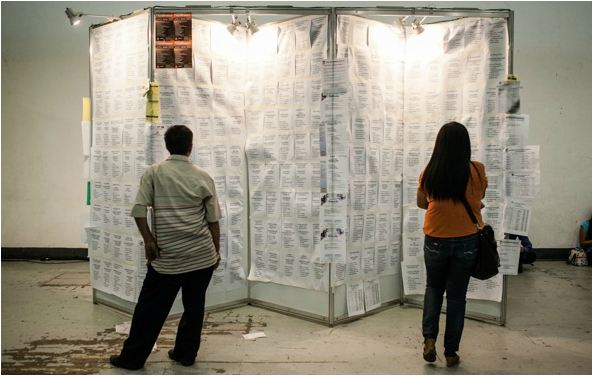By XIANNE ARCANGEL
Photos by MARIO IGNACIO
ALDRIN Ortiz left his house in Nueva Ecija in Central Luzon as early as 3 a.m. on Labor Day, not to attend a workers’ rally but to be among the first applicants to line up at the Labor Day Jobs and Livelihood Fair at the World Trade Center (WTC) job fair in Pasay City.
Ortiz said he wanted to look for a job in Metro Manila because opportunities for young workers and fresh graduates like him are scarce in his province. The 20-year-old Ortiz graduated last month from the Nueva Ecija University of Science and Technology with a degree in Hotel and Restaurant Management (HRM).
“Not a lot of companies in Nueva Ecija are looking forward to hiring HRM graduates like me,” he said in Filipino. “I came here [in Metro Manila] because I think I have better chances of getting hired in the city. There are a lot of restaurants (here where) I could apply.”
Ortiz was among the thousands of jobseekers who participated in the WTC event — one of the 57 job fairs simultaneously staged nationwide by the Department of Labor and Employment (DOLE) on May 1.
Former overseas Filipino worker Martha Golez said she experienced difficulties applying for work at the WTC job fair despite the 134,982 job vacancies being offered (49,982 for local employment and 85,000 overseas).
The DOLE reported that only one out of every five job seekers who went to that event was hired on the spot by companies. The placement rate for the day-long job fair was recorded at a low 19 percent.
Only 744 out of 3,900 applicants for local positions and only 540 or less than half of the 1,320 applicants for foreign jobs were hired. The figures were based on the number of applicants who registered through the Bureau of Local Employment (BLE).
The problem in the case of Golez was her age. The 41-year-old mother worked as a household helper in the Middle East before she was forced to come home in 2008 to take care of her sick mother.
Golez lamented that she was only able to find a handful of companies at the job fair who were willing to accept and evaluate her resume.
“I think I’m highly qualified to be a nanny or a saleswoman because of my experience abroad,” she said in Filipino. “But because of my age, nearly no one is willing to hire me anymore.”
Labor Secretary Rosalinda Baldoz said in a statement that jobseekers should not worry about not getting hired on the spot by companies at the job fair because employers might have wanted them to undergo several processes before hiring them.
“Selecting job applicants can be a tough challenge for employers,” Baldoz said. “They may need more time to review job applications, to go over details of their credentials, and to interview candidates.”
She added: “My advice to applicants is to be optimistic and be a little patient because there will be enough job vacancies and livelihood opportunities for everyone at the job fairs. The processing and hiring by the employers will continue after the job fair, and the DOLE will monitor that.”
Baldoz said the registrants’ applications will be closely monitored by the BLE through PhilJob.Net, its job-matching facility.
As of last year, 2.814 million out of the 40 million economically active Filipinos do not have jobs, according to the Bureau of Labor and Employment Statistics (BLES).
The agency defines economically active Filipinos as those who are at least 15 years old and are either employed or currently seeking employment.
The unemployment rate improved slightly from 7.4 percent the previous year to 7 percent in 2011 because of faster job generation, according to BLES.
The government agency said 1.156 million new jobs were created last year compared to the 974,000 figure of 2010.
Labor groups such as Kilusang Mayo Uno however noted that the decrease in unemployment rate merely corresponded to a 100,000 reduction in the ranks of the unemployed.
KMU added that the increase in the number of underemployed workers from 18.8 percent in 2010 to 19.3 percent in 2011 showed that it was low-quality jobs which accounted for the slight increase in employment.
Data from BLES showed that the number of underemployed persons rose by 401,000, reaching 7.163 million last year.
The National Statistics Office defines underemployment as all employed persons who express a desire to: have an additional job, work additional hours in their present job, or have a job with longer working hours.
(The author is a journalism student of the University of the Philippines who is writing for VERA Files as part of her internship.)
